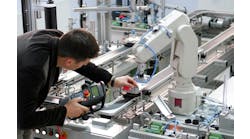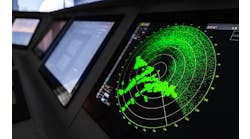Presence sensing is a broad topic that entails both object detection and machine guarding. Choosing the right device always entails some forethought, especially when installing it in difficult-to-reach or hazardous areas. Our panel of experts tells you what you need to know.
With options that range from ultrasonic and photoelectric sensors to capacitive and inductive proximity sensors, what advice can you give on how to choose the right sensor for the application?
Ultrasonic sensors are good for ignoring color, texture and material differences, but they may have issues with angle of incidence or speed or limited space between objects.
Photoelectric sensors are great for either tolerating differences in colors, as infrared LEDs are often utilized, or detecting the difference in colors, like white LEDs do.
Polarized photoelectric sensors can be used to ignore color differences, too, as long as the space in between products is adequate.
Capacitive sensors can be used to detect the presence or level of materials inside of certain packages when sound and light cannot penetrate the packaging materials.
Metal proximity sensors are great for detecting certain kinds of metals, are very affordable and robust but oftentimes operate with very limited sensing ranges.
This is what we all love about the sensing world—it’s very dynamic and ever-changing. No one technology will ever take over the world. Customers want reliability, ease of use, robust housings, form and fit for their various application solutions, so we will all have plenty of opportunities to offer our unique solutions for as long as there are production lines to automate. Even vision has its issues—expensiveness, finding expertise in programming details, lighting, lensing and focus issues.
For magnetic proximity sensors, make sure to understand the difference between reed-based and transistor-based systems to match the sensor to the application, operating conditions, and longevity of the application.
Reed-based sensors have shorter service lives, can be applied in high temperature areas and can be applied where ac power is needed. Transistor sensors have long service lives and no moving parts. The sensor and the actuator should be purchased from the same supplier to ensure detection accuracy.
For inductive proximity sensors make sure to understand that various types of metals have specified sensing ranges. For example, ferrous metals can be detected at significantly longer distances than nonferrous.
Understand the different distance and ambient light requirements of the three types of photoelectric presence sensors—through beam, reflective and diffuse. Diffuse is a single unit and is used in short distances. Reflective has two units and is good at mid-range sensing. And through-beam can be applied for longer-distance presence sensing. There is overlap, so test the samples.
Some factors to consider may be, but are not limited to, the type of target that needs to be detected—that is, what it’s made of or its size; sensing distance needed; environmental concerns, such as IP rating, temperature or shock; and sensor package size or shape.
Optional features of a sensor, such as IO-Link, special cable/connections or even mounting bracketry, may be of importance. Sometimes price can be a point of consideration.
In the end, sensing the target reliably is the key for success, and achieving this is a combination of these factors. A discussion with a trained sensor specialist or engineer can quickly get you on the correct path to spec out a sensor that will work in your application.
To get this right, you need to roll up your sleeves and look at the machine design in detail. And you need to look at where the machine is going to go and what it is going to experience over the course of its operating life; only then can you pick the right sensor.
What do I mean by this? For example, you can pick a sensor for a machine application involving the detection of a stamped steel part very easily. A simple limit switch can detect the presence or absence of this steel part as it passes through the machine. The steel part physically contacts the limit-switch operating lever, and that lever moves to close switch contacts, and the detection is thereby reported to the machine control system. It works great.
Roll up your sleeves, however, and you find out that the machine will run 24/7 in the customer’s installation and they will feed 30 of these parts through the machine per minute. And, with that, your original sensor selection goes from “great” to something less than great, since in a year the switch will be actuated nearly 16 million times. Most limit switches are rated for a mechanical lifetime of between 1 million and 15 million operations and an electrical lifetime often in the range of more like 1 million operations.
So, you use that information to pick a different sensor to address the issue with mechanical and electrical lifetimes. Since the target material is steel, you select an inductive proximity sensor specifically designed for sensing ferrous materials. This type of sensor doesn’t require contact with the target material to actuate, so your mechanical lifetime concern is gone. And with the solid-state electronics found in today’s inductive proximity sensors, the electrical limitations of the mechanically operated switch contacts also fade away. It works great.
Roll up your sleeves a bit further, however, and you find the customer plans in the next one to three years to redesign this stamped-steel part to use a polycarbonate material. And with that your second sensor selection goes from “great” to something less than great, since when that redesign happens the inductive proximity sensors you specified will no longer be able to detect the part.
So, you use all of that information to pick a different sensor, this time a photoelectric sensor. This sensor has the same noncontact operation and solid-state electronics that made the inductive sensor so attractive, and, because it uses light to detect the target, it will function whether the target is the original stamped steel or the redesigned polycarbonate.
So, selecting a presence sensor for an application is easy—any of these three approaches would work on initial inspection. Roll up your sleeves, and dig a little deeper, however, and you’ll find the right sensor every time.
Before the team started selecting hardware, we spent time reviewing how the machine worked and what environment it would be in. We then reviewed what the controller hardware and software needed from the sensor. Our goal was to understand how the sensor data would be processed, displayed and stored. Our rule: The more you know, the better your solution will be.
To get the conversation started, we would ask the following questions.
1. What are we trying to do? Ask questions about how the machine works, what they need to detect and why.
You have to understand how the machine works and what needs to be detected and why before you can determine the sensor type and mounting locations. Here are some examples.
How does it work? Roller conveyor moving product with a 2-inch-high side rail, 48-inch width.
What is being detected? Brown cardboard boxes inside a climate-controlled building.
Why? Sensor detects when a box reaches the end of the conveyor.
2. How do I pick the best technology to detect the target? Pick the best technology based on the measurement range, environment and target properties. Table 1 gives basic performance information on some of the more common sensor technologies and what they are best at.
Download our guide to choosing the right sensing solution at www.controldesign.com/choosetherightsensor.
|
Type |
How it works |
Typical max range |
Best for: |
Not so good for: |
|
Diffused Photoelectric
|
Bounces light off target. Transmitter and receiver in same housing. |
Up to 2 meters
|
Same color targets, cleaner environments, Fast response. Low cost. |
Colors that change, mirrors, clear plastic, dust. Dirty environments |
|
Retro-reflective Photoelectric |
Breaks beam of light. Transmitter and receiver in same housing. Bounces light back with a reflector |
Up to 15 meters |
General detection, Not affected by color changes. Mild industrial applications. Fast response. |
Shiny targets, films, clear material, Reflector must be smaller than target. |
|
Polarized Retro-reflective |
Targets breaks light beam, Transmitter and receiver in same housing uses polarized reflector. |
Up to 11 meters |
Shiny metal targets, not affected by color change, mild industrial. Fast response. |
Clear film, clear materials. Needs polarized reflector. |
|
Through-beam |
Target breaks beam of light, Uses a transmitter and receiver in separate housings |
Up to 60 meters infrared (Laser up to 100 meters) |
Long distance, dusty or steamy environments, worried about lens getting dirty. Fast response. |
Can’t see thin or clear materials. |
|
Inductive proximity sensors |
Only detects metal targets using inductive/eddy current technology. |
Max around 60 mm (2.6 inches) |
Detects only metal targets. Works well in dirty, oily, wet environments, Fast response. |
Will not detect organic material or plastics and has a very short range. |
|
Electromechanical limit switch |
Detection of solid objects by touch. Switches up to 600 V at 20 A, 25 million cycles. |
Up to 200 mm |
Detection by touch. Intuitive and easy to install. No power, software needed. Can directly control power devices |
Head becomes blocked or bent, slow speed, (<1.5 m/s). Mechanical components may wear. |
|
Capacitive proximity |
Uses dielectric strength to measure distance or material differences. Most common use: carpenter stud detector. |
Up to 20 mm |
Detection of any object regardless of material or conductivity. Metal, wood, plastic, glass, cardboard, leather fluids. |
Detects all material, oil, moisture, dirt, humidity. |
Table 1: Pick the best technology based on the measurement range, environment and target properties.
(Source: Telemecanique Sensors)
3. How do I physically attach the sensor to the machine? Here are some examples.
Use a 90° mounting stainless-steel bracket to install an 18-mm-diameter inductive proximity in a washdown area.
A through-beam photo-eye needs to be flush-mounted on the side of the conveyor to keep product from damaging the sensor.
Install a ½-inch national-pipe-thread (NPT) pressure connection T on an hydraulic line, so a pressure sensor can be installed.
4. What is the sensor’s full-scale measurement range? Best practice is to pick a sensor so that the typical measurement from the machine is 40% to 60% of the full-scale range (FSR) of the sensor. Remember that the higher the FSR, the less resolution in your measurement. This will dictate your upper limit. Here are a few examples.
Facility air pressure is typically 100 psi. Select a 200-psi pressure sensor. Pay attention to peak amplitudes that occur during startup or when a valve chatters.
The metal target is 2 mm away. Select an inductive sensor with a range of 4 mm.
If the tank is 2 m tall, then you should use an ultrasonic tank sensor with a range of 4 m.
5. What sensor housing will I need to survive the environment? This is when I use the NEMA and EN 60529, IEC 529 and ingress protection (IP) ratings to help me to specify the sensor body.
A sensor requires an IP68 rating for long-term submersion underwater, while a NEMA 1 rating is good enough for a pressure switch in your basement.
Use the one you are most comfortable with—NEMA or IP codes.
6. What type of output do I need? Discrete, on/off? Solid-state PNP or NPN with 24 Vdc supply? Two- or three-wire 4-20 mA proportional output? Two-wire ac system? Make sure this matches the system controller’s requirements.
7. What type of electrical connection? Does the sensor need an M12, five-pin removable connector/cable, ¾-inch-14 NPTF conduit fitting or an integral 2-m industrial cable? These are some of the more commonly ones used. There are many more.
If you ask these questions before you select a sensor technology, you will have the information you need to select a sensor solution that will give decades of trouble-free service.
- What type of sensing is needed—temperature, pressure, flow, presence, distance, position?
- What is the composition of the target—metallic, nonmetallic, solid, liquid, granular?
- What is the distance to the target?
- What is the needed form factor of the sensor—tubular, block, rectangular?
- What is the control interface—number of pins/wires, PNP vs. NPN, voltage, amperage?
- Do you have any special requirements to consider—contamination, temperature, chips?
- What is the preferred electrical connection—pre-wired cable with flying leads, integrated quick-disconnect connector, pre-wired cable with a molded-on connector?
For machine guarding/safety applications you'll also want to consider how often the machine needs to be accessed for loading/unloading, tool changes, maintenance and repair; existing safety concerns; desired machine performance/throughput; and other safety- and performance-related factors.
For example, laser distance sensors with dual mode measure not just distance, but also light intensity. This allows the sensor to inspect multiple different conditions with a single device, such as whether an object is present, whether multiple objects are stacked and whether an object is oriented correctly. Dual-mode sensors can also detect challenging targets such as clear and reflective objects, targets with low contrast to the background and very dark objects.
These versatile, problem-solving sensors can solve almost any application, and they have a wide variety of sensing modes and ranges available to meet all of your requirements. Standardizing on a powerful sensor provides consistency in programming, limits the number of different sensors on your line and saves inventory costs and spare parts requirements.
Start by learning about the object. Is it thin like a piece of paper or very small like the head of a needle? What is it made of? Is it metal, plastic or other material? Now determine the environment. Is the application in a clean and neat factory or an industrial application with cutting fluids, metal shavings and high temperatures? These items all must be known to determine what sensor would best fit the application. Photoelectric sensors may be better-suited for a cleaner environment and more precise, small objects.
The inductive and capacitive sensors have been proven in industrial applications that may be contaminated with dirt or grease. Knowing the object to be sensed and the environment is an excellent start in selecting a sensor for an application.














